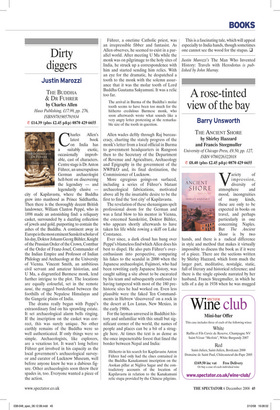Dirty diggers
Justin Marozzi
THE BUDDHA BL DR FUHRER by Charles Allen Haus Publishing, ┬Ż17.99, pp. 276, ISBN9781905791934 Ō£å ┬Ż14.39 (plus ┬Ż2.45 p&p) 0870 429 6655 Charles AllenŌĆÖs latest book on India has a suitably exotic, occasionally improbable, cast of characters. Centre stage is Dr Anton F├╝hrer, an unscrupulous German archaeologist hell-bent on discovering the legendary ŌĆö and legendarily elusive ŌĆö city of Kapilavastu, where the Buddha grew into manhood as Prince Siddhartha. Then there is the thoroughly decent British landowner, William Claxton Pepp├®, who in 1898 made an astonishing find: a reliquary casket, surrounded by a dazzling collection of jewels and gold, purporting to contain the ashes of the Buddha. A continent away in Europe is the most eminent Sanskrit scholar of his day, Doktor Johann Georg B├╝hler, Knight of the Prussian Order of the Crown, Comthur of the Order of Franz-Josef, Commander of the Indian Empire and Professor of Indian Philology and Archaeology at the University of Vienna. Vincent Smith, an ambitious civil servant and amateur historian, and U Ma, a disgruntled Burmese monk, lend further intrigue to the plot. The locations are equally colourful, set in the remote tarai, the rugged borderland between the foothills of the Nepalese Himalayas and the Gangetic plains of India.
The drama really began with Pepp├®ŌĆÖs extraordinary find on his sprawling estate. It set archaeological alarm bells ringing. If the inscription on the casket was correct, this was surely unique. No other earthly remains of the Buddha were so well authenticated. If only things were so simple. Archaeologists, like explorers, are a vexatious lot. It wasnŌĆÖt long before F├╝hrer got involved in his capacity as the local governmentŌĆÖs archaeological surveyor and curator of Lucknow Museum, well before anyone knew he was a dubious figure. Other archaeologists soon threw their spades in, too. Everyone wanted a piece of the action. F├╝hrer, a onetime Catholic priest, was an irrepressible fibber and fantasist. As Allen observes, he seemed to exist in a parallel world. After meeting U Ma while the monk was on pilgrimage to the holy sites of India, he struck up a correspondence with him and started sending him relics. With an eye for the dramatic, he despatched a tooth to the monk with the solemn assurance that it was the molar tooth of Lord Buddha Gautama Sakyamuni. It was a relic too far.
The arrival in Burma of the BuddhaŌĆÖs molar tooth seems to have been too much for the hitherto credulous Burmese monk, who soon afterwards wrote what sounds like a very angry letter protesting at the remarkable size of the tooth in question.
Allen wades deftly through Raj bureaucracy, charting the stately progress of the monkŌĆÖs letter from a local official in Burma to government headquarters in Rangoon then to the Secretary of the Department of Revenue and Agriculture, Archaeology and Epigraphy in the government of the NWP&O and, its final destination, the Commissioner of Lucknow.
More egregious goings-on surfaced, including a series of F├╝hrerŌĆÖs blatant archaeological fabrications, motivated above all by the insatiable desire to be the first to find the ŌĆślost cityŌĆÖ of Kapilavastu.
The revelation of these shenanigans spelt professional doom for the German and was a fatal blow to his mentor in Vienna, the esteemed Sanskritist, Doktor B├╝hler, who appears shortly afterwards to have taken his life while rowing a skiff on Lake Constance.
Ever since, a dark cloud has hung over Pepp├®ŌĆÖs blameless find which Allen does his best to dispel. He also puts F├╝hrerŌĆÖs overenthusiasm into perspective, comparing his fakes to the scandal in 2000 when the Japanese archaeologist, Fujimori, who had been rewriting early Japanese history, was caught salting a site about to be excavated by his team and subsequently confessed to having tampered with most of the 180 prehistoric sites he had worked on. Even less plausible were the faked Ten Commandments in Hebrew ŌĆśdiscoveredŌĆÖ on a rock in the desert at Los Lunas, New Mexico, in the early 1980s.
For the layman unversed in Buddhist history and unfamiliar with this small but significant corner of the world, the names of people and places can be a bit of a struggle here. At times the text is as dense as the once impenetrable forest that lined the border between Nepal and India:
Hitherto in his search for Kapilavastu Anton F├╝hrer had only had the clues contained in the Buddha Kanakamuni inscription on the Asokan pillar at Nigliva Sagar and the contradictory accounts of the location of Kapilavastu in relation to the Kanakamuni relic stupa provided by the Chinese pilgrims.
This is a fascinating tale, which will appeal especially to India hands, though sometimes one cannot see the wood for the stupas. q Justin MarozziŌĆÖs The Man Who Invented History: Travels with Herodotus is published by John Murray.


















































































 Previous page
Previous page